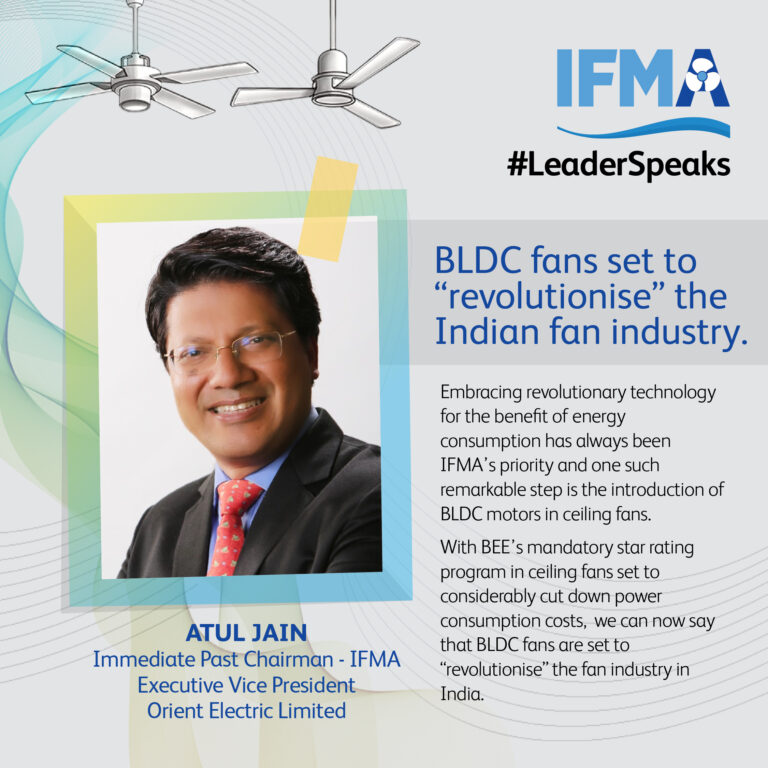One could say that a fan is probably the most omnipresent appliance in India. As an appliance that is a norm in almost every household across India (and increasingly across the globe), the fans industry is currently underrated. In terms of value, the sector is valued at around Rs. 8,000 crore (US$ 1.07 billion), and it produces 60 million units annually. The industry is witnessing an increasing demand year-on-year and undoubtedly is poised for growth. Add to that the fact that we live in an era that has seen more change than ever before with evolution in technology and consumer tastes and preferences. The pandemic too, brought about major shifts in consumer behaviour, further pushing the industry to revolutionise.
If you see the glass half full, you’ll agree that as an industry we have been provided with the much-needed impetus to innovate; and innovations in our sector range from tech to aesthetics, all crafted to suit the lives of our consumers. Technological changes are rapid and are continuously leading to newer solutions that offer better air delivery rate and longer life. An important change comes in form of demand for energy saving appliances. Aesthetics is another key area of prime interest to the consumers and has seen a swift demand over the last couple of years. Staying in at home and rise of social media has created a large demand for an attractive home and thereby demanding appliances look great. We have seen an increase in demand for stylish designs & innovative technologies by households and large players are already capitalising on the demand by offering fashionable yet quality-oriented products. This trend has hit the refresh button for the industry which will only further strengthen the market.
To summarise, we’re at a cusp of major change and the manufacturers should have the following in mind to serve consumers better –
1. Continuous innovation will provide an upper hand. Technology is becoming a major factor in economy as a whole and those will adapt to the innovation culture will excel.
2. Energy efficiency is crucial to consumers. BEE rating is going to be mandatory, and every manufacturer will comply but those who will further march ahead will lead.
3. Aspirations of the country is growing. This means that products must fulfil the expectations in terms of aesthetics and a premium touch.
The Indian Fan Manufacturers Association has played a catalytic role in re-instating these ideologies since its inception. It has been committed to aligning parameters imperative to the survival and growth of the fans industry. With the continuous efforts that the manufacturers and the association have put in to develop quality, sustainable and energy-efficient products, the fans industry has the right mantra to woo consumers and thus witness growth in the years to come.
Frequent storms, torrential rains, flash floods, severe droughts, fierce wildfires, and the list goes on. Climate change has started to impact human lives more evidently and severely. This has drastically changed consumers’ sentiments and their ways of purchasing and interacting with the products. They are becoming more conscious of their purchases and consumption. One such stark transformation we can experience today is in the space of transportation, consumers are adopting more eco-friendly electric vehicles instead of fossil fuel guzzlers.
This shift will be experienced in the Electrical consumer durables space too and ceiling fans are one of those. But even though ceiling fans are arguably the most ubiquitous electrical device in Indian homes and businesses after electric lights, they are rarely discussed in conversations about energy saving. As a result of this oversight, a considerable possibility for energy savings has been lost. Fans utilize nearly 20% of the electricity in Indian households, and their use is steadily increasing. In India, total organised fan production is around 60 million units per year. After deducting 30% for table and pedestal fan sales and exports, annual ceiling fan sales in India are estimated to be around 45 million.
Thus Ceiling fans have a lot of potential for reducing power consumption. Thanks to a technology known as Brushless DC Motor, or simply BLDC motor. This technology is on the verge of causing a paradigm shift in the ceiling fan business. In general, BLDC technology has been on the market for a few decades and is widely used in industries that require high torque motors. What has been missing for a long time is its use in ceiling fans. Induction motors are used in classic fans, and they normally consume 70-90 watts. The power consumption of a BLDC fan, on the other hand, can be reduced by up to 65 percent. Other advantages of using BLDC fans are longer backup on inverters even on Solar, increased reliability, decreased noise production, and longevity of the motor.
The market share of BLDC fans is expected to grow exponentially in the coming years. With the declining cost of electronics cost of manufacturing, BLDC fans cost will reduce significantly. BLDC motors are becoming more popular also due to industry demands for lighter weight, smaller size, and higher power density. The cost of BLDC fans is more, but when we consider the rising cost of power, choosing a super-efficient 5-star rated BLDC fan makes a lot of sense. With the BEE making the requirements for achieving a 5-star energy certification more stringent, the newest rated models are exceptionally energy-efficient, utilizing only 25-35 watts of power.
Looking at the shifting consumer centricities, government policies, and building a sustainable environment adoption of BLDC fans is set to grow. Consumers are also more aware and are shifting towards more eco-friendly ways of living. Due to shifts in ways of working, WFH, and hybrid cultures the interaction with fans as a commodity at home has changed. Consumers want fans that are more premium and provide them savings. As said by Wendell Philips “Revolutions never go backward”, this revolution of BLDC fans is set to change the fans industry radically and bring a wave of highly efficient eco-friendly fans.
As the saying goes, the Stone Age did not end because we ran out of stones; we transitioned to better solutions. The same opportunity lies before us with energy efficiency and clean energy. – Steven Chu
Energy Efficiency simply means using less energy to perform the same task – that is, eliminating energy waste. Energy efficiency brings a variety of benefits like -lowering household costs and the whole economy, reducing demand for energy imports and reducing greenhouse gas emissions.
India’s leadership for energy efficiency has been greatly strengthened through the years. With the Prime Minister setting an aim to make India energy-efficient by 2047, various initiatives are being taken by the government to advance the regulations that reduces and transforms energy consumption.
IFMA, the Indian fan manufacturers association is also committed towards the vision of energy conservation and has whole heartedly welcomed and embraced the mandatory BEE (Bureau of Energy Efficiency) star rating program for ceiling fans from July next year.
IFMA has embarked on the same without compromising on the basic parameters like Air Delivery and other parameters which are of paramount importance to a consumer. IFMA members and other fan manufactures are confident about the success of this BEE initiative thereby ensuring that Indian consumers would be catered and served by genuine and serious manufacturers whose vision are in sync with the Global vision.
It has also been observed that over the years, the consumer purchasing behaviour has changed. They are now not just looking for basic fans but models that are aesthetically in sync with their home decor, high in performance / durability and energy efficient. Because of this behavioural change BLDC motors in Fans being energy efficient are also becoming extremely popular. Due to urbanisation and increasing ‘purchasing power’, it is estimated that the number of individual households and the number of appliances in every household will keep increasing. This phenomenon would make it imperative for all appliances especially fans to be power efficient and would be in complete ‘synergy’ with the BEE and IFMA combined initiative.
IFMA commits to be the frontrunner in embracing sustainable and energy-efficient technology and ensuring effective implementation of all Government initiatives especially the BEE Star labelling requirements.
Relying on the new age, aesthetics, and innovation & technology and now energy saving, it can be summarized and concluded that the fan industry is indeed entering in a “golden era”.
As an artist, I have always been intrigued by traditional art forms. One such thing that not just caught my eye but went on to become my passion is the traditional Indian hand fan, popularly known as ‘Pankha’.
It all started around 40 years ago when I first envisioned collecting these beautiful artefacts. And today, when I look back, I wonder what an amazing journey it has been. The journey that started with scouting for hand fans across Indian villages and towns, is now a few thousand fans old and has fans from several parts of the world.
My collection of hand fans is mnemonic of the places that I have travelled to. From rural India that has kept this rare art form alive to various international destinations that boast a strong fan culture, the collection has fans from almost every location that counts. It also consists of fans that I bought from antique dealers who sold me these fans at sky high rates, on the pretext that these rare pieces of art came from palaces and havelis.
I also collected fans when I visited different countries. Africa, Egypt and the Middle East, far eastern countries like China, Korea and Japan, South East Asia, in particular Indonesia – the entire region has a big fan culture in their everyday life as well as in their traditional dances. Fans come in different shapes and sizes, are made of varied organic materials and are used for different purposes. The collection has a variety of fans. There are antique ceiling fans from the Mughal and Colonial period that were pulled by pankhawala from outside the room and used for large congregations in temples, royal courts and aristocratic darbars and offices. There are fans called phadh, large hand fans held by an attendant for groups of affluent men and women. Then there are ceremonial fans and a large variety of personalised fans of many kinds made by women. Many of them are centuries old and are priceless antiques. The collection also grew with gifts from friends from across the globe.
My collection of hand fans is not just my passion; it’s an attempt to keep the traditional art form alive. And so, I have been participating in exhibitions and shows to draw attention to this rare and dying craft of India.
The first such exhibition where I came out with my collection of fans was the one held at the National Crafts Museum in New Delhi in May 2004. A month later the exhibition moved to the Grand Victoria Memorial in Kolkata. And it didn’t stop there. Since then my collection has been exhibited at several international exhibitions held at places like the Rietberg Museum, Zurich, National Art Gallery, Kuala Lumpur, and the National Museum, Manila, Philippines. In 2011, the collection was exhibited at the ‘Maximum India Festival’ at The John F. Kennedy Centre in Washington DC.
While these exhibitions have played a major role in promoting this rare art form, my concern is that my collection of fans, owing to its fragile nature, may not be able to survive the travel it has to take to different locations. I am, therefore, working on a separate collection of similar fans that can be set aside for traveling to exhibitions, in the future.
The JDCA established in Orissa, 1997, to house the collection of traditional and contemporary arts and antiquities, designed by the eminent architect, B V Doshi. A book on pankha, “To Stir the Still Air,” is being published.
‘Pankha’: Hand fans www.indianhandfans.org
I have been having discussions with the apex body of Indian Fan Industries to house a PANKHA MUSEUM so that legacy of the Pankhas is kept alive. At one point in early nineties, we were quite close to collaborating with the West Bengal Government through my friend Hardeep Singh and the Fan makers Association of India but Alas. That fell apart at the last minute.
May be the Industry body now finds huge merit in this proposal.
The COVID-19 pandemic, an ongoing global pandemic has proven to be a health and humanitarian crisis. The new reality taking shape is made of complexity, uncertainty and even opportunities.
In this fight against Covid-19 pandemic, fans play an important role by improving ventilation and circulation. This places fans as a recognized and a cost-effective method to not only provide thermal comfort but also as a key intervention to prevent COVID-19.
Did you know Fans are your shield against Covid-19?
It is noteworthy to mention that the ‘National Guidelines for Infection Prevention and Control in healthcare facilities’, issued by Ministry of Health and Family Welfare (MoHFW) , Govt. of India in January 2020 states that “use of air supply fans helps improve thermal comfort and maintain good ventilation even where windows or doors are closed.”
Taking a que from the above, several State Governments have also issued several public health advisories on usage of fans. The Government of Haryana’s Public Works Department has issued an advisory asking for ensuring proper ventilation and use fans as a better alternative to avoid spreading of COVID-19.
The Government advisories clearly flow towards the usage of fans against spread of Covid-19 infection. Since fans are a common man product, essential in almost every household across a tropical country like India, importance of fans as an affordable tool in fight against Covid-19 pandemic needs to be highlighted more and more.
The use of fans against Covid-19 is also backed by many international studies, recognizing that ventilation across a closed area is of utmost importance in fight against Covid-19 pandemic.
The guidelines by the Centre for Disease Control, United States have emphasized on the importance of ventilation in buildings as an effective mitigation strategy to reduce the spread of COVID-19 disease and lower the risk of exposure. The guidelines have listed fans under Tools to Improve Ventilation.
From affordability point of view as well, fans have been listed in the guidelines under less than $100 interventions for ventilation.
Thus usage of fans in these difficult times is the need of the hour, as they are, in true sense, Covid warriors for the common person.
Recent Post
Categories
Tags
Bladeless Ceiling Fans BLDC Fans BLDC Motor Ceiling Fans Ceiling Fan Ceiling Fans Dual Blades in Portable Fans Energy Saving Fans Fan Blades Fan Inverters Fan Regulator Fans Fans are Covid-19 warriors Guide to Buying Ceiling Fan History of Electric Fans History Of Fan IFMA IFMA Editorial Indian Fan Industry Induction Motors Ceiling Fan LED Ceiling Fans Low Noise Ceiling Fans Pankahs Pankha Museum Pedestal Fans Portable Fans Remote Control Fan Remote Control of Fans Star Rated Ceiling Fans Unique Blade











